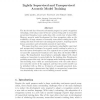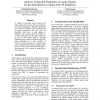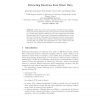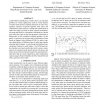106
Voted
ICASSP
2011
IEEE
14 years 4 months ago
2011
IEEE
This paper introduces a method to train an error-corrective model for Automatic Speech Recognition (ASR) without using audio data. In existing techniques, it is assumed that sufï¬...
129
click to vote
CSL
2002
Springer
15 years 8 days ago
2002
Springer
The last decade has witnessed substantial progress in speech recognition technology, with todays state-of-the-art systems being able to transcribe unrestricted broadcast news audi...
123
Voted
PRIS
2004
15 years 1 months ago
2004
Abstract. The main area of work in computer music related to information systems is known as music information retrieval (MIR). Databases containing musical information can be clas...
111
Voted
EVENT
2001
15 years 1 months ago
2001
Determining the occurrence of an event is fundamental to developing systems that can observe and react to them. Often, this determination is based on collecting video and/or audio...
102
Voted
ACL
2001
15 years 1 months ago
2001
This paper addresses recent progress in speaker-independent, large vocabulary, continuous speech recognition, which has opened up a wide range of near and mid-term applications. O...
116
Voted
CEAS
2008
Springer
15 years 2 months ago
2008
Springer
A method is presented which analyses the audio speech data of voice calls and calculates an "acoustic fingerprint". The audio data of the voice calls are compared with e...
107
click to vote
ISMIS
2005
Springer
15 years 6 months ago
2005
Springer
Abstract. Music is not only a set of sounds, it evokes emotions, subjectively perceived by listeners. The growing amount of audio data available on CDs and in the Internet wakes up...
102
click to vote
ICMCS
2005
IEEE
15 years 6 months ago
2005
IEEE
This paper is concerned with modelling background audio online to detect foreground sounds in complex audio environments for surveillance and smart home applications. We examine a...
118
Voted
ICMCS
2006
IEEE
15 years 6 months ago
2006
IEEE
Content-based classiï¬cation of audio data is an important problem for various applications such as overall analysis of audio-visual streams, boundary detection of video story se...
92
Voted
CNSR
2008
IEEE
15 years 7 months ago
2008
IEEE
â Wireless sensor networks (WSNs) can be used to record and store audio data at remote and inaccessible places. However, audio data adds an additional concern to the design of th...




